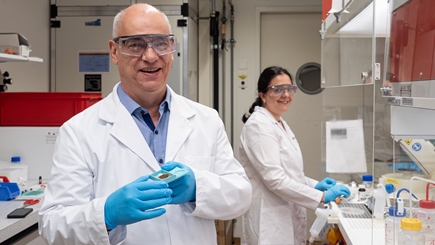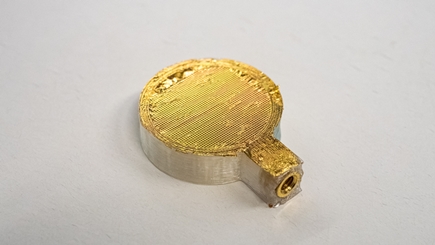Empa spin-off Lepto GmbH
More efficient communication for satellites with terahertz radiation
Terahertz radiation is a promising part of the electromagnetic spectrum that has so far been underutilized. Empa researchers Elena Mavrona and Erwin Hack want to help close the so-called terahertz gap. With their spin-off company Lepto, they manufacture filters and other devices for terahertz radiation, enabling a wide range of applications both in space and on Earth.

The ultrathin foil stretches over its ring-shaped polymer frame. Depending on the angle of view, it appears almost transparent at times, then shimmers in gold, red, and green. This rainbow of colors is caused by the metallic microstructure on the surface of the film: highly precise microscopic patterns made of pure gold. As beautiful as it may appear, the foil is not a decorative object, but a high-tech filter for terahertz radiation, and the first product from the Empa spin-off Lepto GmbH.
Lepto, Greek for thin, is a fitting name, as the filter is just one micrometer – one thousandth of a millimeter – thick. The young company was founded in April 2025 in Dübendorf by Empa researchers Elena Mavrona and Erwin Hack. The scientists had been working together on terahertz radiation at Empa's Transport at Nanoscale Interfaces laboratory for the past six years.
“With wavelengths between 0.03 and 3 millimeters, terahertz radiation lies at the boundary between optics and electronics,” explains Elena Mavrona, now CEO of Lepto. In the electromagnetic spectrum, the terahertz range fits in between shorter-wave area of visible and infrared light and the longer micro- or gigahertz waves that we use for most of our wireless communication technologies, from Bluetooth to Wi-Fi.
Closing the gap

Compared to its spectral “neighbors,” the terahertz band has long been largely unexplored; technologies for generating and measuring terahertz radiation were few and far between. It is only in the last 30 years or so that this so-called terahertz gap has begun to close. This is because terahertz radiation promises versatile applications in medicine, communication, and materials research. Lepto aims to enable precisely such applications with its products: components that allow the emission and detection of terahertz rays.
The spin-off has its roots in a research project in which Hack, Mavrona, and their colleagues succeeded in developing a particularly thin structure for highly effective terahertz filters. They filed a patent for the production technology. “We never actually planned to start a company,” says Erwin Hack, CTO of Lepto. “But we received many inquiries from other research institutions, and they were very satisfied with our filters’ performance. That's when we realized there was a market for them.”
The filters are just the start. “We are also working on other components for terahertz radiation, such as polarizers,” says Mavrona. What sets Lepto products apart from the competition is their thinness. The polymer film that serves as the substrate for the gold microstructure of the actual filter is extremely thin and highly transparent across all areas of the electromagnetic spectrum. This makes the resulting filters particularly effective – but also very light and compact.
For satellites and skin scans

For this reason, the spin-off founders see an important market for their products in the field of space technologies, where the weight of components plays a key role – and terahertz rays have several areas of application. “On the one hand, terahertz spectroscopy is an excellent method for investigating many phenomena in astrophysics and geophysics,” explains Mavrona. “On the other hand, terahertz is also ideal for communication between satellites, as well as satellite-to-ground communication.” According to Hack, the higher frequency of terahertz radiation compared to conventional communication technologies enables faster data transmission. Because the radiation has shorter wavelengths than its “big brother” gigahertz, it does not travel quite as far – an advantage that makes terahertz-based communication technologies more secure.
Space is by no means the only area of application for terahertz radiation and Lepto components. In the atmosphere, the radiation is scattered relatively quickly and only extends over short distances. Nevertheless, it is considered one of the key technologies for 6G, the next standard for mobile communications, which is set to be even faster and more energy-efficient than the current 5G standard.
There is also great potential for terahertz waves in medicine, as they can penetrate superficial tissue layers. Similar to its neighbors in the electromagnetic spectrum, terahertz waves are non-ionizing and therefore safer than X-rays. Since they are surface-sensitive, they are primarily being developed for applications on the skin, such as cancer diagnosis or the examination of superficial blood vessels or wounds. Another field of application is security, for example in body scanners at airports.
Currently, demand for Lepto's terahertz filters and polarizers comes mainly from the research sector. In addition to applications in spectroscopy for characterizing materials, research is also being conducted into terahertz-based quantum computers. “Our filters are very thin, and we manufacture the frames for them to order using 3D printing,” explains Mavrona. This allows the young company to produce complex, yet compact filter systems precisely tailored to customer requirements. “We look forward to bringing our products to market soon,” say the two founders.
Lepto GmbH
Lepto GmbH is an Empa spin-off and is supported by glatec, the Empa business incubator. The founders receive coaching through glatec as well as Initial Coaching supported by Innosuisse. Lepto is backed by additional members of the Transport at Nanoscale Interfaces laboratory, including co-inventor Ivan Shorubalko and advisors Rolf Brönnimann, Tero Kulmala, and Jonas Gartmann. The spin-off is currently seeking pre-seed funding. Elena Mavrona has received the «Empa Entrepreneur Fellowship» for the spin-off.
Dr. Elena Mavrona
Lepto GmbH
Phone +41 76 758 46 47
Dr. Erwin Hack
Lepto GmbH & Empa, Transport at Nanoscale Interfaces
Phone +41 58 765 42 73
Space technologies
Empa's research is conquering space. From components for space probes and imaging techniques for satellites to materials development on the International Space Station: Empa researchers are working on a wide range of materials and technologies for use at the “final frontier”. But no matter how high the research flies, it is still down-to-earth, as technologies for space have a variety of applications on Earth, whether for innovative electronics, medical devices, or monitoring environmental agreements.
Read the EmpaQuarterly online or download the PDF version.
-
Share






